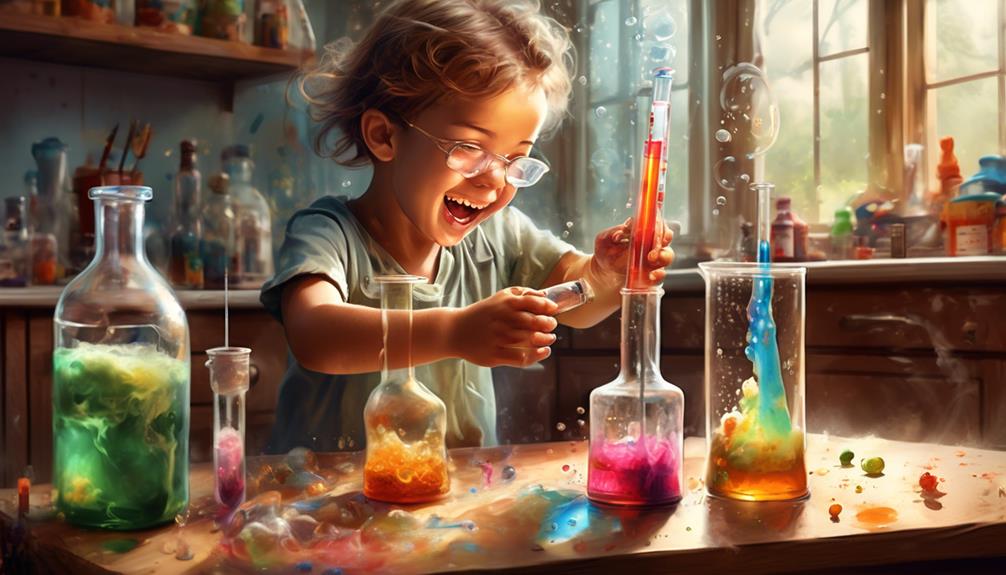Do These Simple Science Experiments at Home

One simple science experiment you can try at home is making a volcano. To do this, you will need baking soda, vinegar, a small container, and some red food coloring. Start by placing the small container on a flat surface. Add a few drops of red food coloring to the container to make it look like lava. Next, add a couple of tablespoons of baking soda to the container. Finally, pour in some vinegar and watch as the mixture fizzes and bubbles, creating the effect of an erupting volcano. This experiment demonstrates the reaction between an acid (vinegar) and a base (baking soda), producing carbon dioxide gas.
Another easy science experiment you can do at home is creating a rainbow in a glass. For this experiment, you will need a glass of water, a white sheet of paper, and a sunny day. Fill the glass with water until it is about three-quarters full. Place the glass on a flat surface near a window where sunlight can pass through it. Hold the white sheet of paper behind the glass, making sure it is in direct sunlight. As the sunlight passes through the glass of water, it will refract, or bend, creating a rainbow effect on the white sheet of paper. This experiment demonstrates how light can be separated into its different colors through the process of refraction.
By grouping complete concepts together, the paragraph structure becomes clearer and easier to follow.
Density Tower
Get ready to be amazed as you create a mesmerizing density tower right in the comfort of your own home! This simple science experiment won't only captivate your senses but also teach you about liquids' density and the concept of floating objects.
To begin, gather a few clear containers of different sizes. Fill each container with a different liquid, such as water, oil, honey, and syrup. Make sure to pour them carefully, as you don't want to mix them up just yet.
Now comes the exciting part! Slowly pour each liquid into a larger container, starting with the densest one at the bottom. Watch in awe as the liquids separate based on their densities, creating distinct layers. You'll notice that the denser liquids sink to the bottom, while the less dense ones float on top.
To make it even more intriguing, you can add small objects like paperclips or grapes to the tower. Observe how they behave differently in each layer. Some objects may sink to the bottom, while others may float at a specific level. This happens because the objects' densities interact with the density of each liquid layer.
Balloon Rocket
Get ready for an explosive experiment that will send you soaring! The Balloon Rocket is a thrilling activity that will teach you about the power of air pressure.
All you need are a few simple materials and some step-by-step instructions to launch your own high-flying adventure.
Materials Needed
To conduct the balloon rocket experiment, gather a few common household items that you probably already have lying around. Here's what you'll need:
- Balloons: These colorful orbs of fun are essential for creating the propulsion needed for your rocket.
- String or fishing line: This will be used as the track for your rocket to zoom along.
- Straws: Attach these to your balloon to guide the airflow and ensure a smooth takeoff.
Now, let's talk about alternative household items for science experiments. Don't worry if you don't have balloons or straws at home! You can use a plastic bottle instead of a balloon and a narrow tube, like a pen barrel, instead of a straw. Get creative with what you have!
Lastly, let's discuss how to safely dispose of experiment materials. When you're done with your balloon rocket, simply deflate the balloon and dispose of it in the regular trash. The string and straws can be recycled if you have a recycling program in your area. Remember, always prioritize safety and sustainability in your experiments!
Step-By-Step Instructions
Now that you have all the materials ready, let's dive into the exciting world of launching a balloon rocket!
Hands-on science experiments aren't only fun but also have many benefits. They help to spark curiosity, develop critical thinking skills, and foster a love for learning.
Before we get started, it's important to create a safe and controlled environment for science experiments. Make sure to have adult supervision, especially when dealing with potentially hazardous materials. Clear the area of any obstacles and ensure there's enough space for the rocket to launch. Additionally, be mindful of any allergies or sensitivities that may arise.
By following these tips, you can enjoy the wonders of science in a safe and controlled manner.
Let's blast off and see how high our balloon rocket can go!
Homemade Lava Lamp
Get ready to create your very own homemade lava lamp! Here's what you'll need:
- a clear plastic bottle
- water
- vegetable oil
- food coloring
- an Alka-Seltzer tablet
First, fill the bottle about three-quarters full with vegetable oil. Then, add water until the bottle is almost full. Add a few drops of food coloring. Finally, drop in a broken Alka-Seltzer tablet.
Watch as the colorful bubbles rise and fall, creating a mesmerizing lava lamp effect.
Get ready for some serious science fun!
Materials Needed
For this exciting homemade lava lamp experiment, gather the following materials:
- A clear plastic bottle: This will serve as the main container for your lava lamp. The transparency will allow you to observe the mesmerizing lava-like movement.
- Vegetable oil: This will be the base liquid for your lava lamp. Its density will create a separation between the oil and water, resulting in the captivating lava lamp effect.
- Food coloring: Choose your favorite color or mix different shades to personalize your lava lamp. The vibrant hues will enhance the visual appeal of the experiment.
Remember to take safety precautions while conducting this experiment. Ensure adult supervision, especially when handling sharp objects like the plastic bottle. In case you don't have vegetable oil, you can use baby oil as an alternative.
Step-By-Step Instructions
To create your own mesmerizing lava lamp at home, follow these step-by-step instructions. But first, let's talk about safety precautions. Make sure to handle all materials with care and have adult supervision if needed. Now, let's gather the common household items you'll need:
| Materials Needed | Quantity |
|---|---|
| Clear plastic bottle | 1 |
| Vegetable oil | Enough to fill ¾ of the bottle |
| Water | Enough to fill the remaining ¼ of the bottle |
| Food coloring | A few drops for a vibrant effect |
Once you have everything ready, it's time to create your lava lamp. First, fill the bottle with water. Next, add the vegetable oil, allowing it to settle on top of the water. Add a few drops of food coloring, close the bottle tightly, and give it a gentle shake. Watch as the colorful blobs rise and fall, creating a mesmerizing display. Remember, science can be fun and educational, but safety always comes first!
Observations and Results
Now it's time to see the mesmerizing results of your homemade lava lamp in action! You've followed the instructions, mixed the ingredients, and watched as the colorful blobs danced and swirled in the water.
But what do these observations mean? Let's dive in and explore the importance of accurate observations and how to interpret the experimental results.
- Observations are crucial because they provide the raw data for your experiment. Pay close attention to the size, shape, and movement of the blobs, as well as any changes over time.
- To interpret the results, compare your observations with your initial hypothesis. Did the blobs move as you expected? Did the colors mix or separate? Consider any unexpected patterns or behaviors.
- Remember that experimental results can lead to new questions and further experimentation. Don't be afraid to think critically and draw conclusions based on your observations.
Invisible Ink
Discover the secret world of invisible ink and unlock a whole new level of creativity and fun! Did you know that you can write secret messages using invisible ink? It's like being a spy with your very own secret code! Imagine the excitement of sending hidden messages to your friends or leaving secret notes for your family. With just a few simple ingredients, you can create your own invisible ink and become a master of espionage.
Spy gadgets have always fascinated us, from hidden cameras to secret compartments. But nothing beats the thrill of using invisible ink to send covert messages. The best part is that it's incredibly easy to make. All you need is lemon juice or baking soda mixed with water, a cotton swab, and a sheet of paper. Simply dip the cotton swab into the invisible ink solution and write your message on the paper. Wait for it to dry, and voila! Your secret message is invisible to the naked eye.
To reveal the message, all you need to do is heat the paper. You can use a hairdryer, an iron set to low heat, or even a candle flame (with adult supervision, of course). As the heat is applied, the invisible ink will oxidize and turn brown, making your secret message magically appear. It's like something out of a spy movie!
Egg in a Bottle
Get ready to be amazed as you learn how to perform the incredible egg in a bottle experiment! This classic science experiment is sure to leave you in awe. Here's how it works:
- Bottle experiment variations: There are several variations of the egg in a bottle experiment that you can try. One popular method involves using a hard-boiled egg instead of a raw one. Another variation involves using a glass with a small opening instead of a bottle. You can also experiment with different types of bottles or containers to see if the results vary.
- Science behind egg in a bottle: The science behind this experiment is all about air pressure. When you light a piece of paper and drop it into the bottle, it heats up the air inside. As the air expands, it creates pressure that pushes the egg into the bottle. When the flame goes out, the air inside the bottle cools down, creating a vacuum. This vacuum pulls the egg back into the bottle, seemingly defying gravity.
- Prepare to be amazed: As you perform the egg in a bottle experiment, you'll witness the egg magically entering the bottle and then reappearing. It's a mind-boggling sight that will leave you wondering how it's possible.
Baking Soda Volcano
Prepare for an explosive science experiment that will make your own baking soda volcano erupt with excitement! This classic experiment is not only educational, but also a whole lot of fun. With just a few simple ingredients, you can create a mini volcanic eruption right in your own kitchen. So, grab your lab coat and safety goggles, and let's get started!
To create your baking soda volcano, you will need the following materials:
| Materials | Quantity |
|---|---|
| Baking Soda | 1 cup |
| Vinegar | 1/2 cup |
| Dish Soap | A few drops |
| Red Food Coloring | A few drops |
First, build the structure of your volcano using clay or papier-mâché. Make sure to leave a hole at the top where the eruption will occur. Once your volcano is ready, place it on a tray or a dish to catch any overflow.
Next, pour the baking soda into the volcano's opening. Add a few drops of dish soap and red food coloring to the vinegar, to mimic the color and texture of lava. Then, carefully pour the vinegar into the volcano.
As soon as the vinegar reacts with the baking soda, get ready to witness a fantastic volcanic eruption! The mixture will bubble and fizz, creating a foamy lava-like substance that flows out of the volcano.
This experiment demonstrates the chemical reaction between vinegar (which contains acetic acid) and baking soda (sodium bicarbonate). When the two substances mix, they produce carbon dioxide gas, which creates the exciting eruption.
Now that you know the secret behind the baking soda volcano, you can impress your friends and family with this explosive experiment. Just remember to have fun and stay safe as you explore the wonders of science!
Dancing Raisins
Ready to witness a mesmerizing scientific phenomenon? Get ready to be amazed as we explore the captivating world of dancing raisins!
Prepare to be captivated by these three incredible aspects of dancing raisins:
- Carbonated Grapes: Did you know that grapes can become carbonated? By soaking them in a fizzy drink, like soda water, the carbon dioxide bubbles cling to the grapes, causing them to rise and fall in a beautiful dance. It's like a miniature ballet happening right before your eyes!
- Vinegar and Baking Soda Reaction: Get your raisins grooving by combining vinegar and baking soda! When these two ingredients mix, a chemical reaction occurs, resulting in the release of carbon dioxide gas. As the gas bubbles rise, they attach themselves to the raisins, causing them to float and move around in the liquid. It's like they've come alive and are showing off their dance moves!
- The Science Behind It: The secret behind the dancing raisins lies in the carbon dioxide gas. As the raisins absorb the gas, they become buoyant and float to the surface. Once they reach the surface, the gas escapes into the air, causing the raisins to sink back down. This cycle repeats, creating a mesmerizing dance that will leave you spellbound.
Static Electricity
Discover the shocking world of static electricity and prepare to be amazed by its electrifying effects! Static electricity occurs when electric charges build up on the surface of an object. This phenomenon is caused by the triboelectric effect, which happens when two materials come into contact and exchange electrons. One material becomes positively charged, while the other becomes negatively charged.
To help you understand this concept better, check out the table below:
| Positive Charge | Negative Charge |
|---|---|
| Glass | Rubber |
| Silk | Plastic |
| Wool | PVC |
| Fur | Vinyl |
| Aluminum | Acrylic |
Now that you know which materials create positive and negative charges, you can have fun experimenting with static electricity at home. Rub a balloon against your hair and watch as it sticks to the wall. Or, try rubbing a comb against a woolen sweater and then bringing it close to small pieces of paper. You'll be amazed as the paper jumps towards the comb!
Static electricity is not only fascinating but also has practical applications in our everyday lives. It is used in printers, photocopiers, and air purifiers to attract dust particles. So, next time you experience a small shock when touching a doorknob, remember the incredible power of static electricity!
Frequently Asked Questions
How Can I Safely Dispose of the Materials Used in These Experiments?
To safely dispose of the materials used in these experiments, follow some safety precautions. Check if any items can be recycled or reused, and dispose of others in an eco-friendly way.
Are These Experiments Suitable for All Age Groups?
Are these experiments suitable for all age groups? Yes, they are! Science is for everyone, regardless of age. These experiments can be modified to suit different age groups, providing hands-on learning and fostering curiosity.
Can I Use Alternative Materials if I Don't Have the Specific Ones Mentioned in the Article?
Sure, you can definitely use alternative materials if you don't have the specific ones mentioned in the article. Just make sure to take necessary safety precautions and have fun experimenting!
Is Adult Supervision Necessary for These Experiments?
You may be wondering if adult supervision is necessary for these experiments. Well, let me tell you, my friend, when it comes to safety, having that extra pair of eyes is always a smart move. So, yes, adult supervision is a must! Make sure to follow all safety precautions.
Are There Any Potential Hazards or Risks Associated With These Experiments?
When experimenting at home, it's important to be aware of potential hazards. Take safety precautions like wearing goggles or gloves, and make sure to follow instructions carefully. Stay curious, but stay safe too!











